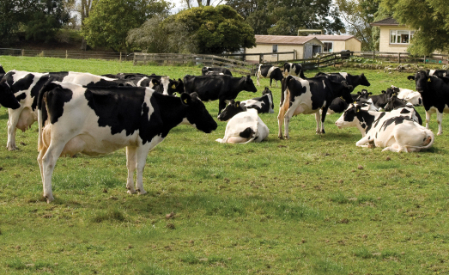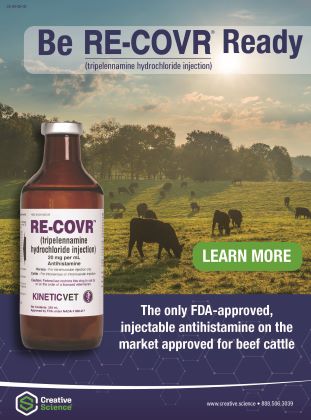Developing a Healthy Herd

Developing a Healthy Herd
Herd health has always been a complex concept to quantify and qualify. It is difficult to breed for, hard to measure as a return on investment, and comprises a myriad of treatment and prevention options.
The immune system of each animal is the foundation for longlasting health. Building immunity against the majority of diseases starts with calf care, but it must be continued through the lifetime of the animal through vaccination protocols, biosecurity measures and good daily management practices.
One particularly difficult hurdle dairies face is the impact of subclinical cases of disease and persistent infections. It’s common knowledge that even mild cases still impact productive life and longevity to some degree. But it is very difficult to know just how bad the impact is, especially on an animal-by-animal basis.
Good health management begins with a good approach, starting with calfhood all the way through the final lactation.
The Basic Foundation
Herd health is a major goal for many producers. As more research has come out on the impacts of poor health and a heightened awareness of good welfare practices, health has become a greater pursuit for the whole industry.
One of the biggest ways this is being accomplished is a stronger emphasis on immunology. This includes common practices like feeding only high-quality colostrum, greater biosecurity, especially for calves and youngstock, and implementing rigorous vaccine protocols.
Another element that is not quite as commonplace but can be highly effective is a dedicated sick animal facility to quarantine and stop the spread of disease. Unfortunately, too often it’s a challenge for farms to set aside dedicated buildings and spaces for ill animals. Likewise, it is difficult to spot and treat animals who are undergoing stressful events which weaken their immune systems, which makes them susceptible to disease.
To overcome these challenges, the whole farm team should take on a “herd health mindset” and be trained to spot the telltale signs of an immunocompromised or injured animal and understand the responsory protocol.
Common Diseases
There is a laundry list of diseases that can arise in many different shapes. Many of them can be avoided through careful observation and management.
Well-balanced nutrition plays a huge role, not only in keeping cattle healthy, but also ensuring the animal receives the proper balance of vitamins, minerals and other nutrients to prevent deficiencies that could lead to other risks.
For example, cows who are deficient in vitamins A and D along with selenium have more incidents of retained placentas and other postpartum issues, according to a University of Nebraska-Lincoln Bulletin, Dairy Cow Health and Metabolic Disease Relative to Nutritional Factors.
Other nutrition issues are more directly related to overall intake and body condition score (BCS) due to energy metabolism issues.
Fat cow syndrome
This is when a cow has a high BCS and is near calving. This underlying condition can cause other metabolic problems such as milk fever, ketosis, displaced abomasum, retained placenta, metritis, and more.
Ketosis, which is essentially a nutrient deficit due to postpartum energy demands, is also associated with similar diseases including fat cow syndrome, retained placenta, mastitis, metritis and displaced abomasum.
Acidosis
Which is a common problem among dairy cattle and caused from an imbalance of pH in the rumen (an environment that is too acidic). Making sure to have adequate fiber in the diet can help reduce the chances of acidosis.
Laminitis
Or Commonly known as founder, along with a whole other host of hoof issues such as white line diseases and ulcers, can also be caused by improper diet.
Close up prepartum cows could potentially experience hypocalcemia (aka milk fever). This is caused when a cow is unable to meet the large calcium demand required by the onset of milk production post calving.
Calf Diseases
Calves are susceptible to other diseases such as scours or pneumonia. Both of these can have lifelong repercussions. They may have reoccurring infections, commonly called “lungers,” or be chronic underperformers due to permanent lung damage.
There are several pathogens that can cause both scours and pneumonia. It is not uncommon for a calf to suffer multiple infections at once. Taking samples and running lab tests are the best ways to identify and combat issues with a targeted treatment program.
Common causes of diarrhea include coccidiosis, Cryptosporidium parvum, Bovine Diarrhea Virus (BVDV), Coronavirus, Rotavirus, Salmonella species, E. coli, and a few others. It is common for calves to develop pneumonia prior to weaning and share risk factors associated with those that develop diarrhea.
Preventions and Protocols
We cannot discuss prevention protocols in livestock health without making mention of the changes that happened in June 2023 regarding restrictions on formerly over-the-counter antibiotics.
This decision, while frustrating to some, was implemented to reduce antibiotic abuses and misuse. However, this does not mean all these products are no longer available. They simply can only be purchased with a prescription via an active veterinary-client-patient-relationship, or VCPR.
That said, the best health protocols and products are those that focus on prevention rather than treatment.
Vaccine protocols are especially advantageous during the times that animals may experience immune suppression. Proper timing ensures they can weather events without being negatively impacted.
On large dairies, communication is essential to ensure that protocols are followed through without variation, no matter who is fulfilling them. Different products and administration techniques can easily throw a team off, so make sure that all changes are posted and discussed thoroughly.
Though vaccination protocols may cost money and require time and planning up front, they can save money and headaches in the long run. Effective protocol reduces treatment costs and frequency. And, a healthy animal is less likely to experience a drop in production.
Biosecurity measures are also important as they ensure new animals entering the farm don’t bring in something that could go through the herd. The best plans begin with the calf barn, as diseases tend to flow downstream from the older animals to the vulnerable youngstock. Typical measures include footbaths, separate facilities and a regular disinfection routine of facilities.
Other elements might include:
- Maintaining a closed herd
- Quarantining animals when symptomatic or returning from off the farm
- Keeping sick pens isolated
- Use of disinfectants for boots, facilities and all equipment that comes into contact with cows
Health and the Future
Measures to maintain and prevent cow health will undoubtedly continue to advance in the future as innovation and technology develop. There is much work being done to make them cost effective and practical for day to day use.
Some of these developments include mRNA vaccines (not yet commercially available for cattle), machine vision and artificial intelligence to monitor cow behavior and health, gene editing for health traits, rumen boluses that monitor internal function, and environmental monitors among others.
Though advances can help make a sound program better, it begins with the basics. Which is a strong protocol that is consistently accomplished day in and day out by a trained, caring team.
By Jaclyn Krymowski.
For Cattle Industry News check out the webpage below
Or if you enjoy the Outdoors. The Iowa Sportsman might be a great page to check out.



